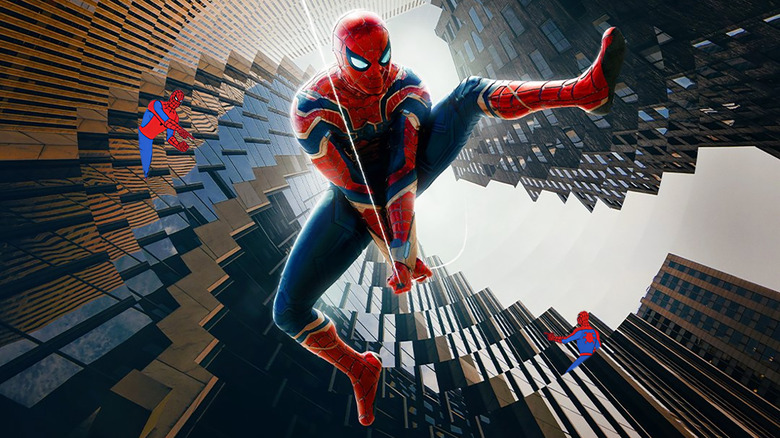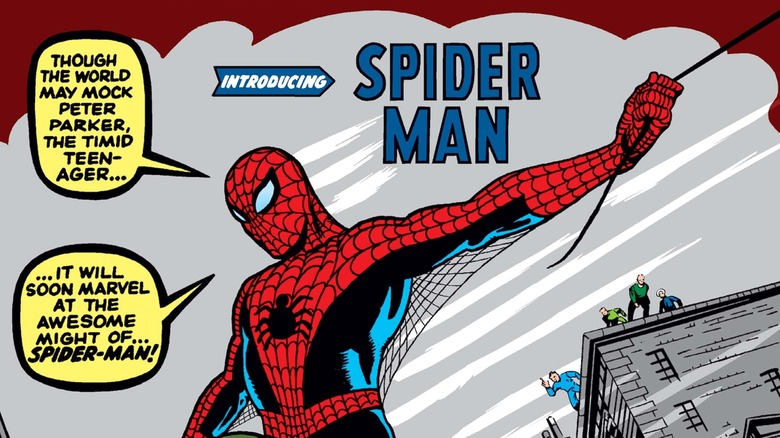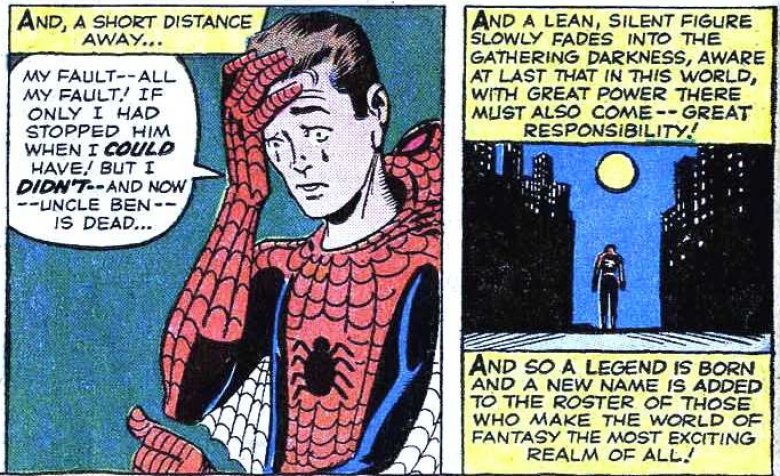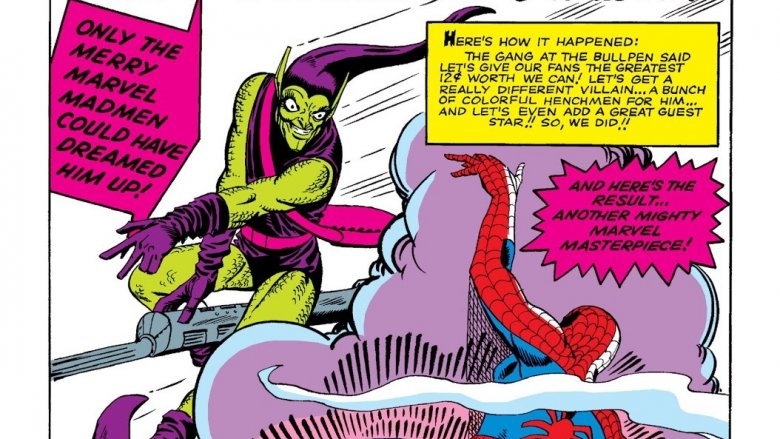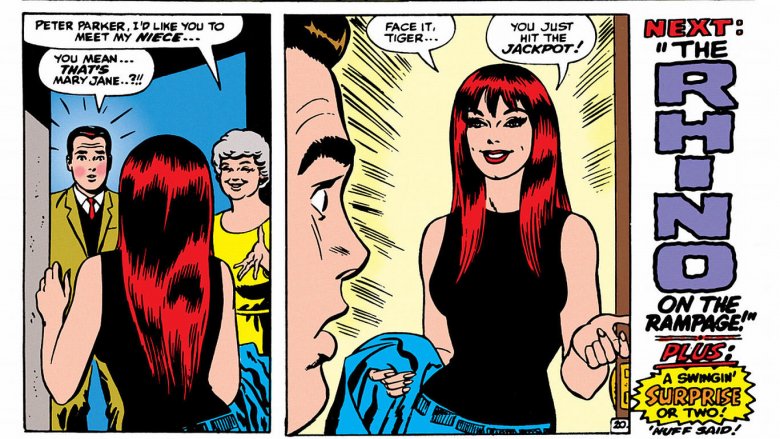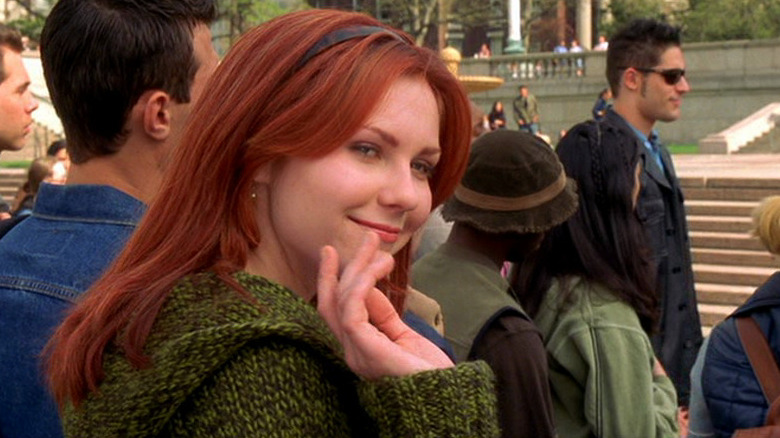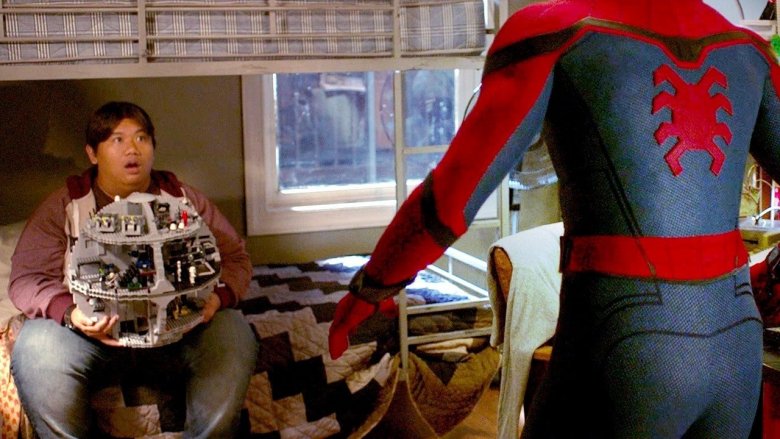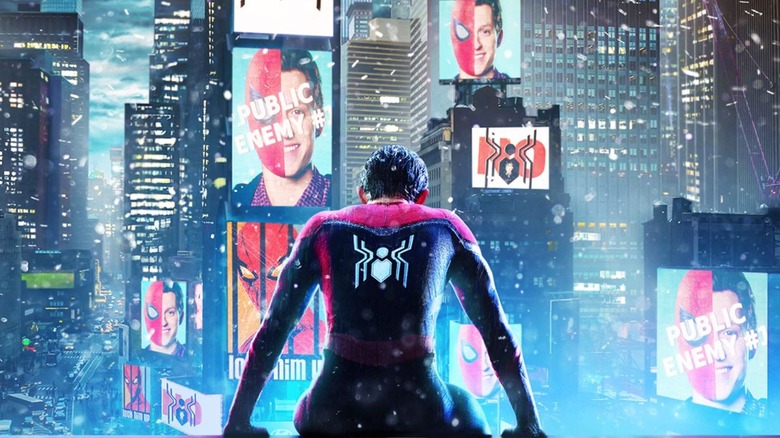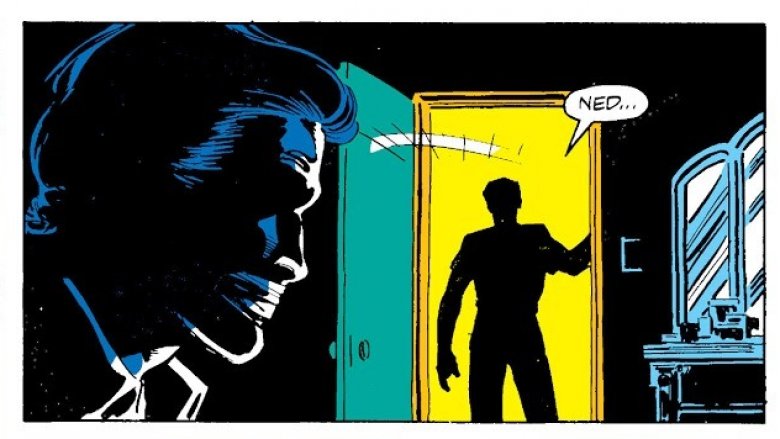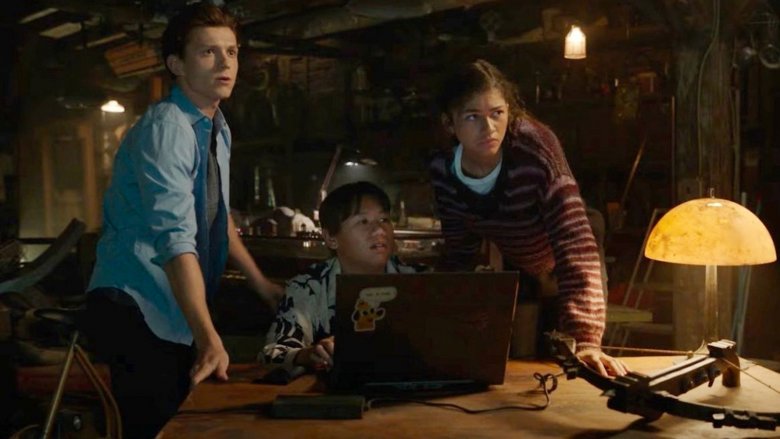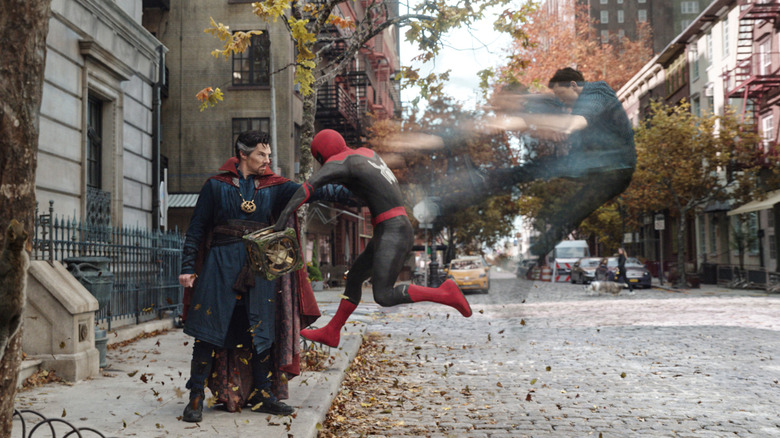Easter Eggs You May Have Missed In Spider-Man: No Way Home
Forget popcorn — the best kind of theater snack is an Easter egg. And "Spider-Man: No Way Home" is packed with so many comic book references, movie references, inside jokes, and easy-to-miss details that if Tony Stark was still around he'd probably declare another moratorium on pop culture quips. Amid the chaos of returning supervillains and multiverse rifts, there are plenty of gems to be found — and we've collected them all in one place.
Needless to say, there will be major spoilers for "Spider-Man: No Way Home" from here on out. Abandon all hope of remaining unspoiled, ye who enter here.
Or, you know, just wait until you've seen the movie to read this article.
Comic Book Easter Eggs
Let's start the comic book references in "Spider-Man: No Way Home" at the beginning. No, not the beginning of the movie — the beginning of Spider-Man.
The quote "with great power comes great responsibility" became widely known after Uncle Ben spoke it in Sam Raimi's "Spider-Man," but that's actually not the exact quote from the comics. It's lifted from "Amazing Fantasy" #15, the 1962 comic where Peter made his debut as the web-slinging hero, and it is connected to Uncle Ben's death. As faithfully adapted in 2002's "Spider-Man," Peter Parker initially uses his powers for personal gain, but he is taught a hard lesson when a thief he allowed to go free ends up killing Ben. The comic then ends on a rather somber note, but with an important message:
When Aunt May dies at the hands of Green Goblin in "Spider-Man: No Way Home," she uses her final moments to tell Peter, "with great power there must also come great responsibility." The comics' wording is perhaps a little less streamlined than the version that later became better known, but it's still a nice callback to Spider-Man's first appearance. And it's not the only one!
Credit is due to "Spider-Man: No Way Home" costume designer Sanja Milkovic Hays for finding a way to weave Green Goblin's classic costume from the comics into the movie without the need for a suit-crafting montage. When Norman Osborn arrives in the Marvel Cinematic Universe, he initially resists his darker half and smashes the Green Goblin mask before seeking refuge with Aunt May at the food kitchen where she works. Aunt May throws together some donated clothes for Norman to wear — a purple hoodie and green coat — and as strips of fabric are torn away during Green Goblin's later fight with Spider-Man, the ensemble starts to look a little something like this:
Now that MJ and Peter are finally together (for a week, anyway), "Spider-Man: No Way Home" has a nod to the first time that Mary Jane's face was actually seen in the comics. As she "welcomes" the now-infamous Peter Parker back to Midtown High in a news bulletin, Betty Brant encourages him to, "Go get 'em, tiger!"
This is a reference to Midtown High's mascot, a tiger, but it's also a familiar nickname. For a while in the early "Amazing Spider-Man" comics, there was a running joke that one of Aunt May's friends was always trying to set Peter up with her niece, Mary Jane Watson, but Peter was too focused on to his extra-curricular superhero activities. When Peter finally did meet MJ, she confidently told him to his flabbergasted face:
Here are some of the other comic book Easter eggs to keep an eye out for in "Spider-Man: No Way Home."
- The car carrying the MIT admissions lady has the license plate number "65A5M-3." This is presumably a reference to "The Amazing Spider-Man" #3, the comic where Doctor Octopus made his debut, and therefore a very appropriate Easter egg to usher in Doc Ock's arrival.
- A graffiti artist is on the loose in NYC! Some hooligan who goes by the handle "Ditko." This villainous vandal's handiwork can be seen on the roof of Midtown High, and on the side of Aunt May's F.E.A.S.T. van.
- After Flash Thompson finds out Peter Parker's secret identity, he makes the bold choice to reinvent his look with frosted tips — an ode to Flash's blond hair in the comics.
- Flash's memoir is called "Flashpoint" in a nod across the aisle to DC Comics. "Flashpoint" was a major multiverse crossover event published in 2011, and was the inspiration for the plot of the upcoming "Flash" movie.
- This is more webcomic than comic book, but KC Green's eternally relevant "This Is Fine" cartoon makes an appearance in the form of a sticker on the back of Ned's laptop. Perhaps it sums up how MCU New Yorkers feel when an alien spaceship goes screeching past their window for the third time that week.
- Ahead of the final battle, Peter 2 (Tobey Maguire) does positive affirmations with Peter 3 (Andrew Garfield) that consist of repeatedly telling him he's "amazing," and encouraging Peter 3 to tell himself he's amazing as well. Peter 3 is, of course, from the "Amazing Spider-Man" movies, which added the "Amazing" to the title to set them apart from Raimi's trilogy.
Superhero Movie References
"Spider-Man: No Way Home" has quite a few nods to previous "Spider-Man" movies. For example, did you know that Alfred Molina also played Dr. Otto Octavius in "Spider-Man 2"? Only true fans will know!
OK, perhaps a section listing every single reference to previous "Spider-Man" and MCU movies isn't practical, so we'll stick with the more subtle nods. At the end of "Spider-Man: No Way Home," Peter heads to the coffee shop where MJ works in order to get her caught up again after all her memories of Peter Parker (along with everyone else's) are magically deleted by Doctor Strange. As Peter stands in the doorway of the coffee shop, MJ looks up at him and appears to recognize him. A few moments later, however, it's revealed that she was actually greeting Ned, not Peter. It parallels an early moment in "Spider-Man" when Tobey Maguire's Peter Parker thinks that MJ (played by Kirsten Dunst) is waving at him, and waves back ... only to realize too late that she was actually waving at her friend.
Some of the references fall outside of the Marvel-sphere, including one of the cleverest. Tom Holland's Spider-Man is, as established in "Captain America: Civil War," a big fan of "that really old movie, 'Empire Strikes Back.'" So is Ned Leeds, who discovered Peter was Spider-Man by accident when he dropped by to work on their LEGO Death Star model. The model was destroyed in "Spider-Man: Homecoming" and makes a return in "Spider-Man: No Way Home" ... only to get destroyed again. As fans of those really old movies will know, the Death Star being blown up was the climactic moment of both the first and third entries in the original "Star Wars" trilogy, so it's only appropriate that it gets destroyed in this trilogy-closer as well.
Perhaps the greatest movie reference in "Spider-Man: No Way Home" is a reference to a movie that never actually got made. Back in the 1990s, before Sam Raimi arrived on the scene, James Cameron was in line to direct a "Spider-Man" movie, and wrote a "scriptment" for it (halfway between a script and a treatment). The article that MJ is reading on the roof of Midtown High, which causes her to joke about Peter seducing her with his hypnotic spider moves? That was an actual scene in Cameron's "Spider-Man." Here's a racy excerpt.
Spider-Man moves in a hypnotic arc around her. He raises his hands in a dance-like movement. Lowers them.
SPIDER-MAN: The female usually signals her willingness by an uncharacteristic passivity
MJ takes a deep breath. Her lip trembles. Her knees are weak. Her eyes, though, are steady, gazing at the silhouette before her. She doesn't move or speak. He moves closer
SPIDER-MAN: In certain crab spiders, such as Xysticus, the male will attach strands of silk to the female... tying her limbs...
Spider Man moves his hand gracefully across her, and she sees the sheerest silk webbing glinting in the moonlight. First one wrist. Then the other. Hypnotic movement in the moonlight. Her arms are bound to the wall. Her breathing gets more rapid.
Phew! Once you get back from taking a cold shower, here are some other movie Easter eggs that pop up in "Spider-Man: No Way Home."
- Norman Osborn says the thing.
- Delmar's Deli, the local bodega that was trashed by the ATM thieves in "Spider-Man: Homecoming," is seen again in "No Way Home" and has fortunately been restored to its former glory.
- One of the news tickers references a Czech Republic superhero called "Night Monkey," confirming that Ned Leeds' hastily made-up superhero name in "Spider-Man: Far From Home" has caught on.
- Listen carefully when Sandman is cured of his sand-curse, and you'll hear strains of Danny Elfman's theme from the original "Spider-Man" trilogy being woven into Michael Giacchino's "No Way Home" score.
- Tony Stark's well-meaning but klutzy robot lab assistant DUM-E has found refuge at Happy Hogan's condo.
Foreshadowing
Some of the Easter eggs in "Spider-Man: No Way Home" feel more like foreshadowing for the future of the MCU than throwaway treats.
Let's start with Ned Leeds learning that Peter 2's best friend died in his arms after trying to kill him, which prompts Ned to promise Peter 1 that he will never become a supervillain and try to kill him. This is a nod to the fact that the comic book version of Ned Leeds briefly wore the mantle of the supervillain Hobgoblin. And as for dying in Peter's arms ... well, in the 1987 comic "Spider-Man versus Wolverine," Peter Parker does indeed walk into Ned's apartment to find him murdered, his throat slit. It's a dark moment, and one that hopefully won't make its way into the MCU.
It doesn't look like "Spider-Man: No Way Home" actually is setting up Ned to become Hobgoblin, but interestingly it does lay the groundwork for him to become a superhero in his own right. While visiting Doctor Strange in the Sanctum Sanctorum, Ned mentions that his grandmother told him that magic runs in their family, and that sometimes he gets a tingling sensation in his fingers.
Doctor Strange dismissively tells Ned to see a physician, but gets his comeuppance when Ned ends up wielding Strange's pilfered sling ring for the rest of the movie, using his innate talent for magic to open up portals. Keep in mind that it took Stephen Strange forever to learn this simple spell, partly due to a mental block where he believed his injured hands would make doing magic impossible. Ned, meanwhile, manages the portal spell on the first attempt without any training at all. Perhaps Doctor Strange could learn a little something from Ned about the value of an open mind.
"Spider-Man: No Way Home" foreshadows the arrival of other villains more overtly. In the mid-credits scene, Eddie Brock and Venom accidentally leave behind a little Venomlet when they get zapped back to their own universe, potentially setting the stage for the MCU's own version of Venom.
Peter Parker being the first person that Venom bonds with is a crucial part of Venom's origin story in the comics, since newborn symbiotes have a tendency to strongly imprint on the first person that they successfully bond with, taking on some of that person's qualities and personality traits. When Spider-Man abruptly rejected and abandoned his black Spider-suit, Venom was left traumatized and became consumed by a burning hatred for his former partner. The MCU now has a fresh opportunity to adapt this classic storyline — or perhaps the Venomlet could just bond with that Mexican bartender and make him preternaturally skilled at playing soccer.
More potential villains can be glimpsed when the multiverse begins to crack apart and people start to emerge from rifts in the sky — including shapes that look like they could be Kraven the Hunter and Rhino. Perhaps the most exciting bit of possible foreshadowing, however, comes in a small moment where Electro apologizes (in his own way) to Peter 1 for all the trouble he's caused. Noting how similar their backgrounds are and the fact that Spider-Man always seems to stand up for poor people, Electro admits to being disappointed that Spider-Man isn't a black guy under his mask. Peter consoles him by suggesting that there might be a black Spider-Man somewhere out there in the multiverse.
There is, of course, and not all that far away. Alongside the live-action "Spider-Man" movies, Sony has two upcoming animated sequels to "Spider-Man: Into the Spider-Verse," which centers around the Afro-Latino Spider-Man also known by his alter ego, Miles Morales. Miles is currently pretty busy with his own movie franchise, but perhaps we could see a live-action version of him join the MCU somewhere down the line. Or perhaps Tom Holland's Peter Parker could have a cameo role in the "Across the Spider-Verse" movies, á la "Space Jam"/"Who Framed Roger Rabbit?"
Fun Details
"Spider-Man: No Way Home" definitely rewards a second and even a third watch with fun details that you may not notice the first time around. For example, when J. Jonah Jameson makes his initial broadcast revealing the true identity of Spider-Man, he does so using a DIY camera set-up while sitting in front of a green screen in his crappy-looking apartment. When we catch up with the Daily Bugle later in the movie, it's now operating out of a proper studio and Jameson has a full staff at his disposal. This (along with Jameson shilling supplements) is a none-too-subtle parody of the real-life outrage merchants that have flourished in the age of YouTube, making a very decent living out of stoking hatred.
The scene where Doctor Strange thrusts Peter's soul out of his body also has some interesting details. Strange is surprised when Peter's vacant body continues to keep the magic box out of reach, saying he shouldn't be able to do that. This is presumably Peter's Spider-Sense (or, to use its proper name, "Peter Tingle") at work, operating his body without the need of his mind. However, my personal favorite detail in this scene is the fact that Peter's shoelace is untied in his astral form. If the astral form is a pure manifestation of a person's self-image, then this means that Peter's shoelace is untied on a spiritual and metaphysical level. I can relate to that.
"Spider-Man: No Way Home" is in theaters now.
